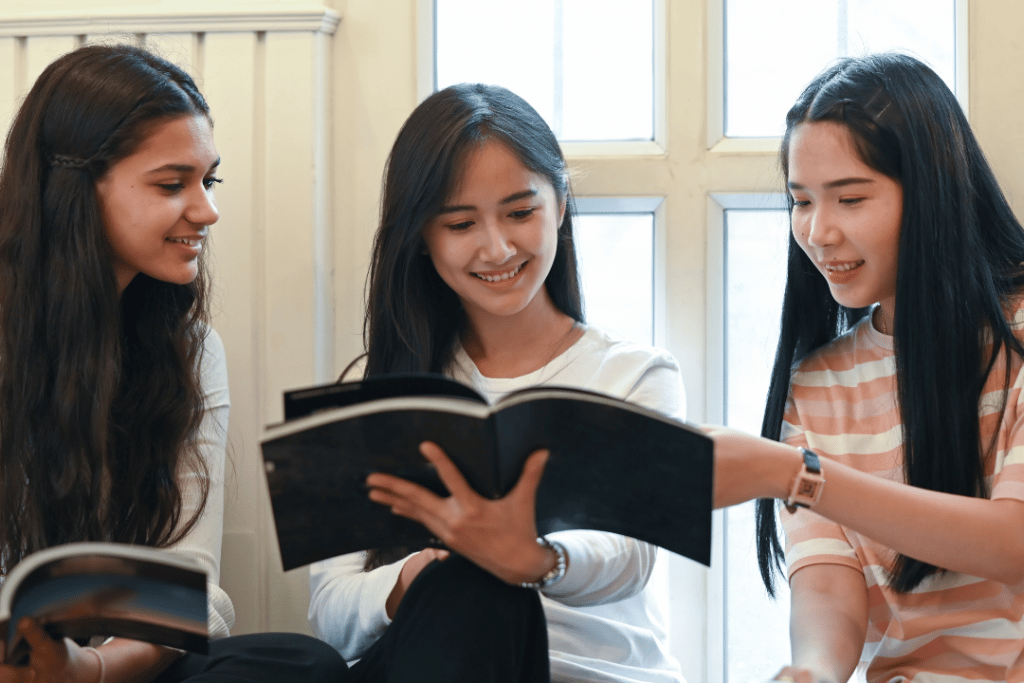Close reading strategies can help students improve their literacy; according to the U.S. Department of Education, 43 million adults in the United States have low literacy skills. Starting in kindergarten, teachers work tirelessly to help students improve their literacy skills so they can one day be functioning members of society. In search of effective strategies, they often use close reading in their classrooms.
Table of Contents
- What is Close Reading?
- A Step-by-Step Guide to Close Reading
- Tips To Implement Close Reading in Your Classroom
- 15 Strategies to Make Close Reading More Effective
- FAQs About Close Reading

What is Close Reading?
Close reading is a reading and comprehension strategy that encourages students to examine a text deeply. It forces them to slow down and carefully examine a text, analyzing it beyond a basic summary. When close reading, students read a passage more than once, and they search for complex meaning.
Because many students (and teachers) tend to shy away from difficult texts, close reading is an important literacy strategy that prepares students to understand complex information once they move on and leave school. The ultimate goal of any teacher should be to equip students to live successful lives after they leave school.
Close reading also forces students to slow down in a world that is increasingly fast-paced and where information often comes in short bursts. Many people today consume information in the form of tweets, social media posts, or short videos. This can make close reading difficult for some students, but all the more important.
Close reading isn’t just important in the language arts classroom. It can be used in all disciplines to help students thoroughly understand the content. Teachers in math, science, history and other disciplines use close reading to help their students understand the content.
How do you set up close reading in a classroom and what are some close reading tips, and which strategies for close reading are most effective?

A Step-by-Step Guide to Close Reading
Step 1: Choose a passage to examine.
Choose a passage to examine. A good passage is one that either has a strong meaning or that students are interested in. Read more below about how to choose a good passage.
Step 2: Print Passage:
Print the passage out or send it to students on devices so they can annotate the text. You can also give students post-it notes if they are using a text that cannot be marked up.
Step 3: Student Reading
Ask students to read the text. This can be done individually or as a group. After they’re done with their first read, check for basic comprehension. You might ask students to answer a set of questions or to summarize the text.
Step 4: Annotation
Ask students to read the text again, this time annotating the text. Depending on the age and experience of the students, you might need to give them annotation guidelines. For example, you might ask them to highlight important ideas in blue, put question marks next to parts they don’t understand, and write one connection they can make between the text and the outside world.
Step 5: Conclusions
Come to a conclusion about the text. You might ask students to answer questions, explain the importance or purpose of the text, or make a conclusion about the text using evidence to support their claim.
There are many different ways to practice close reading, but this is a general blueprint you can follow each time you close read with your students. Change up what students annotate for or the type of conclusions you ask students to come to at the end, but stick to the same general process every time. This consistency helps students master the process of close reading.

Tips To Implement Close Reading in Your Classroom
Implementing close reading in your classroom is an excellent way to help students get more meaning out of the text. Here are some tips to implement close reading.
How to Choose a Close Reading Passage
Close reading can help your students dive deeper into a topic you are studying. If this is your goal, choose a short passage that challenges students to think deeply about a topic. This might be a paragraph in a novel students are studying or a section in a textbook.
Alternatively, close reading can be a standalone strategy that students learn in language arts class. In this case, you might want to choose a difficult or complex passage about a topic that is highly interesting to students.
How to Read Out Loud
When you begin a close reading, especially with young or struggling readers, read the text out loud the first time. Ideally, the teacher or a strong reader will do the first out-loud read. This should be done slowly and with little to no error.
Comprehension Questions
Comprehension questions can help guide students as they practice close reading. When you’re close reading, you want students to look at a text deeply, so your questions should follow suit. For example, rather than asking “What color was the bike?” consider asking “Why do you think Jane chose to ride her bike over other forms of transportation?”
Take It Slow
Close reading can be difficult for students. Like any skill, the more they practice, the better they’ll get. When you first start, do plenty of scaffolding and modeling. Consider having students work in groups or pairs until they become comfortable with the strategy.

15 Strategies to Make Close Reading More Effective
There are so many ways to make close reading fun and effective. Try out some of these strategies in your classroom.
1. Read With a Pencil
Close reading is active reading. When students read with a pencil, they interact with the text by underlining and writing symbols. They might put a heart by a sentence they love, or they might circle a word they don’t understand. You can make this strategy fun by adding in highlighters, markers, crayons, or stickers. Reading with a pencil is one of the most important aspects of close reading.
2. Create Anchor Charts
An anchor chart is like a key for close reading. It reminds students what they should be doing as they read, and it shows them symbols they can use as they annotate their reading. A close reading anchor chart helps keep students on task, and it makes the directions and objectives clear.
3. Color Code Annotations
Provide students with markers, crayons, or highlighters and ask them to color-code their annotations and responses. This strategy works really well for visual learners. This can also help engage learners who are artistically inclined. This is one opportunity where doodling and making a visual masterpiece of their classwork is encouraged.
4. Use Sticky Notes
When you’re working out of a novel or textbook that students can’t write in, use sticky notes to annotate the text. Sticky notes also tend to be fun and engaging for younger kids.
5. Read with Different Lenses
As the John Lubbock quote goes, “What we see depends mainly on what we look for.” Ask students to look for different things each time they read the text. First, they might read to understand. Next, they might read to determine the tone of the writing. Next, they might read to understand a character’s traits, and so on. As long as you keep the close reading process consistent, they could easily be able to change up what they’re looking for each time.
6. Build Phonemic Awareness
For young readers who may not be able to extrapolate deep meaning from text, practice building phonemic awareness when close reading. By asking them to go back through the reading and focus on phonemes, you strengthen both their reading speed and comprehension.
7. Zoom In and Out
Encourage students to zoom in and focus on minute details of the text, like a single vocabulary word. Conversely, encourage students to zoom out and look at the text with a wider lens. You might ask them how the text relates to current events today. You can even split the class into two different groups. Half the class zooms in and the other half zooms out. Then, pair students together so they can learn about the text from the other perspective.
8. Make it Creative
Close reading doesn’t have to only be about analyzing difficult texts. Choose texts that students will have fun reading, and get creative with your assignments and comprehension questions. Ask students to do some creative writing in response to the passage.
9. Work Together
Close reading can be difficult, especially for younger students and struggling readers. Put students in groups to work together, complete a close reading as a class, or have young students work with an adult. When you provide these supports and close reading examples to students, they’ll be less likely to be frustrated and give up.
10. Spread it Out
Close reading doesn’t have to happen all in the same lesson. You can continually return to a text with students throughout the day, week, or unit. Maybe on Mondays, you do a first read. On Tuesdays, you pick out challenging vocabulary. On Wednesdays you ask questions about the text, and so on. The more you return to a text, the more comfortable students will become with breaking it down.
11. Give Choice
There are a lot of textual elements students can look for when they close read. Give them some agency in their learning by allowing them to choose what they want to focus on. Create a chart or list of close reading options that they can easily refer to.
12. Mix it Up
When close reading, not every student needs to read the same passage. Consider allowing students to choose which passage they want to analyze. This is a great way to introduce collaboration as well if you have students present their chosen passage to the rest of the class.
13. Take Your Time
Close reading is supposed to be a slow process, and both students and teachers have been known to try to rush it. Allow your students to take their time through a text. Introduce concepts slowly. Let the process unfold without rushing it. Consider making a close reading portfolio with your students so they can look back and see how they have progressed over time.
14. Don’t Forget Informational Text
Close reading is often used to decipher fiction texts, but it can be a great tool for informational text as well. Teach students how to analyze and comprehend complex nonfiction texts as well.
15. Make it a Project
If you really want students to dive into a text, turn the culmination of their close read into a project. Ask them to create a poster, present it to the class, or create their own piece of writing as one of your close reading strategies.
FAQs About Close Reading
Close reading is important because it encourages students to closely analyze a text. It forces them to slow down, interact with the text, and really think about what it means to them. When students read a text closely, they learn how to comprehend a text. They also learn how to make connections and find meaning in what they read.
Teaching close reading to students is a process that can take quite some time. Start by modeling close reading to them, and slowly take away supports as they become more independent. First, ask students to read the text once. Then, ask them to read it again more slowly, this time annotating and marking up the text.
Ultimately, the focus and goal of close reading should be to come to a better understanding of the text. Students might study the author’s purpose, how the text relates to the outside world, or what the vocabulary in the text means, for example.

By Alicia B
Alicia is a writer who specializes in education and parenting. She holds a bachelor’s degree in education from Penn State University and a master’s degree in education from Michigan State University. Her work has been featured by Scholastic, Insider, MSN, Yahoo, AARP, and more.
